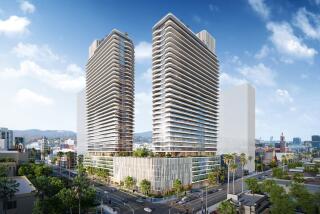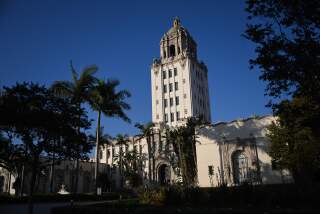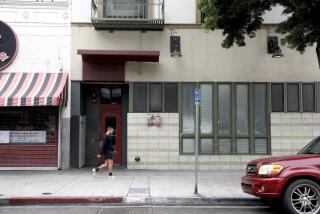After the bust, prime parcels at cut-rate prices
- Share via
Scattered around town are some surprisingly valuable vacant lots disguised by weeds or broken blacktop or the remains of an unwanted building -- and many have quietly come to market, thanks to the real estate collapse.
Billions of dollars were lost by developers who bought land to build high-profile projects but weren’t able to get their plans off the ground, even after spending lavishly on architectural designs and other measures to get their buildings approved by local officials. As the real estate cycle plays out, the pained exit of ambitious builders has created an unusual abundance of opportunities to buy expensive eyesores.
FOR THE RECORD:
Prime real estate: An article in Sunday’s Business section about prime pieces of property for sale in the Los Angeles area said Taylor Grant was the receiver for a large parcel for sale at Playa Vista that contains the hangar where aviator Howard Hughes built the Spruce Goose airplane. Bill Hoffman, president of San Diego-based Trigild, is the receiver for the site that contains the historic Hughes properties. —
“There are a mess of these around town,” real estate appraiser Steven Norris said. “Dirty corners entitled for high-rises and they’re just parking cars on them.”
A common theme in the failed ventures is that the developers bought their sites at astronomical prices near the top of the market, paying so much that they had to plan buildings they could sell or rent at the highest prices the market has ever borne if they hoped to reap a profit.
In the commercial real estate boom of the late 1980s and early ‘90s, developers thought office buildings were the way to go. This time, the consensus was that the most money could be made by creating lavish high-design apartments or condominiums that would appeal to the ultra-rich.
These units were intended for buyers so wealthy that their main challenge wasn’t coming up with millions of dollars to spend but rather to find a dwelling that suited their refined tastes, developers said. It turned out that the target market of international jet-setters, movie stars and corporate barons wasn’t as deep as many had hoped.
So the fact that many of these parcels come with hard-won government approvals for platinum-level developments doesn’t necessarily add to their value, said Norris of Norris Realty Advisors.
He estimates that such commercial properties are worth about 40% to 60% of what they were at their peak in late 2007 and early 2008. But with today’s tight credit market and tougher lending standards, few deals are being done.
“The fact is,” Norris said, “so far nobody has displayed the wherewithal to acquire these.”
Prime parcels at cut-rate prices: B6
Historic downtown site
One of the most ambitious projects proposed during the last real estate boom was a $1-billion high-rise condominium complex intended to tower over downtown Los Angeles.
At 76 stories, the taller of two planned towers would dramatically alter the skyline and rival the US Bank skyscraper, the tallest building in the West. The project, named Park Fifth, also calls for a 14-story five-star hotel overlooking Pershing Square park, fronting on 5th Street.
But with downtown’s condo market overbuilt and the hotel industry in the dumps, there is little need for the project.
Developer David Houk hasn’t given up on building Park Fifth, but one of his financial partners had less patience and put the site on the market last year. Africa Israel Investments Ltd., a publicly traded development company based in Israel, tried to find a buyer for the 100,000-square-foot property but didn’t receive an acceptable offer, real estate brokers said. The company didn’t respond to requests for information about its current plans for the property.
Houk has demonstrated almost supernatural persistence for a developer, having started acquiring the land at the northeast corner of 5th and Olive streets in the 1970s. The site cater-corner to the historic Biltmore Hotel is used for parking now but was one of the most important locations in the city for nearly 100 years. The largest auditorium in Los Angeles, Hazard’s Pavilion, was built there in the 1880s. The wood-frame structure hosted operas, balls, political meetings and sporting events.
In 1906, it was demolished to make way for a new auditorium with an art-nouveau interior that took over as the city’s main entertainment venue. From 1920 to 1964, it was the home of the Los Angeles Philharmonic Orchestra. The Philharmonic Auditorium Building was demolished in 1985 to make way for an office development that never panned out.
Sour Candy in Beverly Hills
It just doesn’t get any better than this if you’re a real estate developer: eight acres in Beverly Hills at the junction of Wilshire and Santa Monica boulevards.
The 9900 Wilshire Blvd. site next to the Beverly Hilton Hotel was once home to one of the best stores in the Robinson’s department store chain. After more than half a century in business, the store ceased operations as a Robinson’s-May in 2006, paving the way for redevelopment.
Property owner New Pacific Realty Corp. proposed a spectacular $500-million condo and retail development designed by celebrity architect Richard Meier, who also designed the Getty Center.
It was to be environmentally friendly and produce no more car trips than the department store did, but many nearby residents still objected to growing density in the neighborhood.
Real estate industry observers were caught by surprise in 2007 when high-flying Brits Nick and Christian Candy swooped in and paid $500 million to buy the property. Candy & Candy catered to the super-wealthy jet-set and vowed that 9900 Wilshire would become one of the world’s most elite addresses.
The decision by New Pacific -- which paid $33.5 million for the site only a few years earlier -- to sell the undeveloped site to the Candy brothers soon looked prescient. The real estate crash and other issues, including the failure of their Icelandic banker, brought down the Candys’ dreams in Beverly Hills. In February, a bank controlled by Mexican billionaire Carlos Slim foreclosed on the property.
Banco Inbursa has yet to officially market the property, real estate brokers said, but investor interest is expected to be strong. The price is unlikely to approach the assessed value of $520 million given it by the city last year.
Ready and waiting in WeHo
One of the largest undeveloped parcels on the Westside is a crescent-shaped lot on San Vicente Boulevard in West Hollywood near Cedars-Sinai Medical Center.
During the last housing boom, developers planned a luxurious condominium called Greenwich Place intended to appeal to doctors, entertainment professionals and other wealthy individuals.
The design called for 116 condos plus 35 rental units for low-income seniors on a site that is also close to the Beverly Center mall and Pacific Design Center.
The current owners paid $57 million for the land at San Vicente and Sherbourne Drive north of Beverly Boulevard in a neighborhood the locals call Sherbourne Triangle. The three-acre parcel has been assembled over a period of decades, first by Cedars-Sinai, which wanted to put a major medical building on the site.
Nearby residents objected to the expansion of the medical center, and West Hollywood officials were reluctant to approve a tax-exempt use for the site. A potential buyer couldn’t get approval to build a hotel there. Cedars sold the property in 2004 to Regent Properties, a residential developer.
Among the land cleared to make way for development was the home of Tail O’ the Pup, the tiny hot dog-shaped food stand familiar to generations of Angelenos.
Regent sold to developer Turnberry Ltd. at the top of the market in late 2007. Now the market has cooled, and Turnberry is unlikely to recoup its $57 million, even though the hard work of getting city approval for the residential development was completed by Regent.
“It’s a fully entitled project in the city of West Hollywood,” said real estate broker Joseph Grabiec of the Harris Group. “It’s difficult to get through the process there.”
A Westside ‘jewel’ beckons
One of the most sought-after development sites in the country is on a short stretch of Santa Monica Boulevard between Beverly Hills and Century City across from the Los Angeles Country Club.
New York developer Donald Trump was among the competitors in a hot bidding war during a bankruptcy auction of the 2.4-acre lot at 10000 Santa Monica Blvd. in 2006. Irvine home builder SunCal Cos. won the parcel with a bid of $110.2 million in the 52nd round of the auction when Trump and his partners finally threw in the towel.
“This piece of property is the jewel of California,” SunCal’s chief operating officer, Frank Faye, said at the time.
SunCal hired one of the world’s star architects, Frenchman Jean Nouvel, to come up with a cutting-edge design for the site. He proposed a wisp-thin 45-story tower of ultra-luxury condominiums with plants and private gardens growing on every level. The total expected cost of the tower Nouvel called “the green blade” was $400 million. But in 2008, amid the drop in demand for new homes and the collapse of its banker, Lehman Bros. Holdings Inc., SunCal filed for bankruptcy protection on the project.
Now it’s for sale again. Real estate broker Jeff Adkison of Jones Lang LaSalle declined to speak about the potential price, but he expects there will be strong interest from developers and large investment funds based overseas.
Among the possibilities, according to its allotted “trip count” of automobile traffic, are either 283 residences or 214 hotel rooms. Offices or a retail center would also be allowed, but a high-rise such as the one Nouvel proposed could command views of the ocean, Hollywood Hills and downtown Los Angeles.
“It’s an irreplaceable piece of land,” Adkison said.
Ocean breezes for a song
One well-known property on the block for a fraction of its last sale price is the Campus at Playa Vista.
The 56-acre site near Marina del Rey is one of the most desirable parcels in the country for developers because it’s near the ocean and comes with approval for the construction of more than 500,000 square feet of office and retail buildings.
The parcel, where DreamWorks SKG once planned to build a major film studio, also includes the enormous hangar where aviator and business mogul Howard Hughes built his infamous Spruce Goose airplane in the 1940s. The hangar is now frequently used as sound stages for making movies and television shows.
New York developer Tishman Speyer and financial partner Walton Street Capital paid $200 million for the campus 2 1/2 years ago during the real estate boom and built four office buildings before defaulting on a $155-million loan last summer.
The court-appointed receiver managing the property, Taylor Grant, said in January that he hoped to get more than $100 million for it.
More than a dozen offers have been received, said Grant’s real state broker, Kevin Shannon of CB Richard Ellis. “We are trying to see what the best price and terms will be.”
Earlier this month the Los Angeles City Council approved the final phase of the Playa Vista development. Phase 2, known as the Village, will add 2,800 homes, a shopping center, office buildings and parks to the community that already includes more than 3,000 residential units and eight office buildings.
The addition of the long-awaited retail component is expected to add value to the rest of Playa Vista, real estate experts said.
Golden opportunity on Wilshire
A block and a half east of Beverly Hills’ Golden Triangle is a block-size vacant lot smack on Wilshire (9200, to be exact).
The one-acre parcel between Maple and Palm drives was supposed to hold a six-story residential and retail complex by now, but instead it’s for sale. Pasadena developer HDS Group paid $54 million for the land when the market was hot. The parcel was reassessed at $52 million in 2008 as the market began to tumble, and HDS never got the project moving.
The property should sell at a substantial discount from its assessed price, brokers say, but its prime location is expected to bring out deep-pocketed buyers.
“We just started marketing it,” said broker Shannon, “but we anticipate a good reception. It’s a rare opportunity in any real estate cycle to get a block in Beverly Hills.”
The site is a bit of an oddity. Even though it’s a prime location close to the headquarters of the Academy of Motion Picture Arts and Sciences, the land has been empty for many years. In 1987, Columbia Savings & Loan tied up the property in a 99-year lease as part of a plan to erect buildings on four Wilshire Boulevard sites in Beverly Hills. Columbia’s real estate division built two fancy office buildings on Wilshire, including its opulent onetime headquarters, but went out of business in 1991 without developing 9200 Wilshire.
HDS Group got city approval to build 44 condos above ground-floor retail and four levels of underground parking. The design called for a rooftop pool with cabanas and a clubhouse. New owners will probably tweak the plans to suit their tastes and the current market, Shannon said.
“Different buyers have different ideas of what the highest and best use is,” he said.
More to Read
Inside the business of entertainment
The Wide Shot brings you news, analysis and insights on everything from streaming wars to production — and what it all means for the future.
You may occasionally receive promotional content from the Los Angeles Times.











